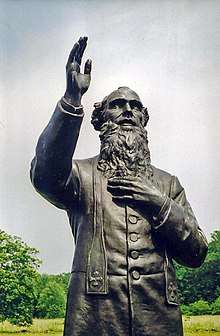William Corby
| The Very Reverend William Corby C.S.C. | |
|---|---|
 | |
| 3rd President of the University of Notre Dame | |
|
In office 1866–1872 | |
| Preceded by | Patrick Dillon |
| Succeeded by | Auguste Lemonnier |
|
In office 1877–1881 | |
| Preceded by | Patrick Colovin |
| Succeeded by | Thomas E. Walsh |
| Personal details | |
| Born |
October 2, 1833 Detroit, Michigan |
| Died |
December 28, 1897 (aged 64) South Bend, Indiana |
The Rev. William Corby, CSC (October 2, 1833 – December 28, 1897) was an American priest of the Congregation of Holy Cross, and a Union Army chaplain in the American Civil War attached to the Irish Brigade. He served twice as president of the University of Notre Dame.
Biography

.jpg)
He was born in Detroit, Michigan, to Daniel Corby, an Irish immigrant, and his wife Elizabeth, a Canadian. He attended public school until age 16, then joined his father's real estate business. In 1853, he enrolled in the 10-year-old college of Notre Dame in South Bend, Indiana, and began study for the priesthood three years later. Following ordination, he taught at Notre Dame, and served as a local parish priest.
He served as chaplain of the 88th New York Infantry, which was one of the five original regiments in the Irish Brigade. His memoir of the Irish Brigade became a best-seller.[1]
Irish Brigade
He is perhaps best known for giving general absolution to the Irish Brigade on the second day of the Battle of Gettysburg. Of the Brigade's original 3,000 men, only about 500 remained, and more than a third of them were killed or wounded in the battle. The scene of Fr. Corby blessing the troops was depicted in the 1891 painting Absolution under Fire by Paul Wood,[2] and dramatized in the 1993 film Gettysburg.
A statue by Samuel Murray – Father Corby, with right hand raised in the gesture of blessing – stands upon the same boulder on which the priest stood while blessing the troops that morning. It was the first statue of a non-general erected on the Gettysburg Battlefield, and was dedicated in 1910.[3]
He is widely remembered among military chaplains and celebrated by Irish-American fraternal organizations. Corby Hall at Notre Dame is named for him, and a copy of the Gettysburg statue stands outside the building. An organization of Notre Dame alumni is named The William Corby Society.[4]
President of the University of Notre Dame
Following his service in the Civil War, he returned to Notre Dame and served as its vice-president, 1865–66; and president twice, 1866–72 and 1877-81. Under Corby's first administration, enrollment at Notre Dame increased to more than 500 students. In 1869 Corby opened the law school, which offered a two-year course of study, and in 1871 he began construction of Sacred Heart Church, today the Basilica of the Sacred Heart, Notre Dame. The institution was still small, and Corby taught in the classroom and knew most students and faculty members. In 1869, the entire student body and the faculty presented him with the gift of a 'black horse and, when he left the presidency three years later, they presented him with a matching carriage.[5]
Corby became president again following the short term of Fr. Patrick Colovin. When Corby returned to the presidency, Notre Dame had not yet become a significant academic institution. Corby's presidency saw the April 1879 fire that destroyed the old Main Building of the school. Corby sent all students home and promised that they would return to a "bigger and better Notre Dame." Corby overcame the $200,000 fire loss and rebuilt the Main Building - which now stands with its "Golden Dome." In addition to his presidency, he was serving as the Holy Cross Provincial, when Rev. Sorin, who had become Superior General of the Congregation, wrote to him to tell him that he would have to relinquish one of his positions. Corby wanted to remain president, but was overruled by Sorin.[6]
See also
References
- ↑ "Past Presidents // Office of the President // University of Notre Dame". Retrieved May 28, 2017.
- ↑ "Rev. William Corby at Gettysburg". www.archives.nd.edu. University of Notre Dame Archives. 2 July 2013. Retrieved 26 February 2016.
Corby's famous absolution has since been immortalized, among other places, in Paul Wood's Absolution under Fire (1891) at the Snite Museum of Art and in statues on the Gettysburg Battlefield (1910) and on Notre Dame's campus (1911).
- ↑ Father William Corby from Stone Sentinels.
- ↑ William Corby Society
- ↑ Miller, Greg. "A Notre Dame Procession" (PDF). Scholastic Archive. The Scholastic. Retrieved 8 December 2017.
- ↑ Miller, Greg. "A Notre Dame Procession" (PDF). Scholastic Archive. The Scholastic. Retrieved 8 December 2017.
Sources
- Bergen, Doris L. (ed.). The Sword of the Lord: Military Chaplains from the First to the Twenty-First Century. Notre Dame, IN: University of Notre Dame Press, 2004. ISBN 0-268-02175-9.
- Corby, Fr. William, CSC. Memoirs of Chaplain Life: Three Years with the Irish Brigade in the Army of the Potomac. Edited by Lawrence F. Kohl. New York: Fordham University Press, 1992. ISBN 0-8232-1251-3
External links
- Father William Corby from Irish Cultural Society of the Garden City Area.
- William Corby Archives from University of Notre Dame.
- William Corby at Find a Grave